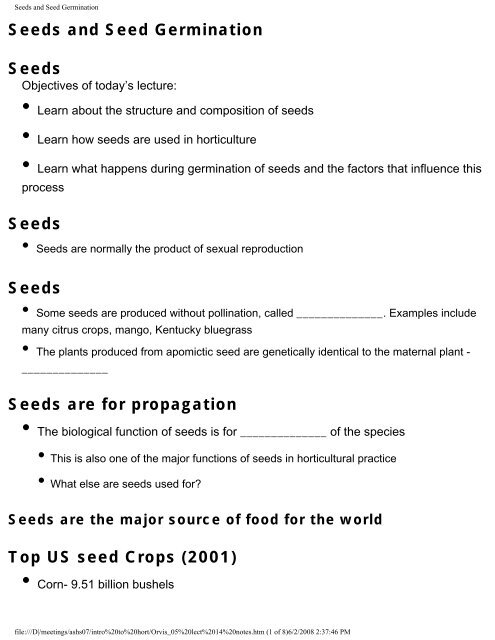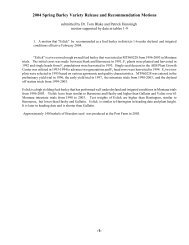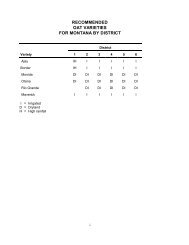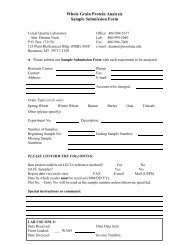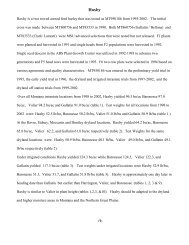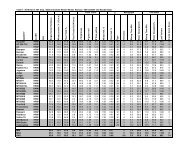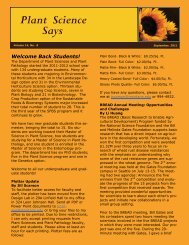Seeds and Seed Germination
Seeds and Seed Germination
Seeds and Seed Germination
Create successful ePaper yourself
Turn your PDF publications into a flip-book with our unique Google optimized e-Paper software.
<strong><strong>Seed</strong>s</strong> <strong>and</strong> <strong>Seed</strong> <strong>Germination</strong><strong><strong>Seed</strong>s</strong> <strong>and</strong> <strong>Seed</strong> <strong>Germination</strong><strong><strong>Seed</strong>s</strong>Objectives of today’s lecture:• Learn about the structure <strong>and</strong> composition of seeds• Learn how seeds are used in horticulture• Learn what happens during germination of seeds <strong>and</strong> the factors that influence thisprocess<strong><strong>Seed</strong>s</strong>• <strong><strong>Seed</strong>s</strong> are normally the product of sexual reproduction<strong><strong>Seed</strong>s</strong>• Some seeds are produced without pollination, called ______________. Examples includemany citrus crops, mango, Kentucky bluegrass• The plants produced from apomictic seed are genetically identical to the maternal plant -______________<strong><strong>Seed</strong>s</strong> are for propagation• The biological function of seeds is for ______________ of the species• This is also one of the major functions of seeds in horticultural practice• What else are seeds used for?<strong><strong>Seed</strong>s</strong> are the major source of food for the worldTop US seed Crops (2001)• Corn- 9.51 billion bushelsfile:///D|/meetings/ashs07/intro%20to%20hort/Orvis_05%20lect%2014%20notes.htm (1 of 8)6/2/2008 2:37:46 PM
<strong><strong>Seed</strong>s</strong> <strong>and</strong> <strong>Seed</strong> <strong>Germination</strong>• Sorghum (for grain) – 515 million bushels• Rice – 213 million hundred weight• Soybeans- 2.89 billion bushels• Wheat 1.4 billion bushels• Oilseed- 80 million tons<strong><strong>Seed</strong>s</strong> are alive!• To function in propagation, seeds must be ______________• <strong><strong>Seed</strong>s</strong> ______________ (slowly)• consume O 2 , produce CO 2 <strong>and</strong> H 2 O• <strong><strong>Seed</strong>s</strong> have a ______________ lifespan• They cannot be stored indefinitely<strong><strong>Seed</strong>s</strong> are alive!• <strong><strong>Seed</strong>s</strong> of many tropical plants remain viable for only a short time, a few______________• Tropical plants grow in environments that do not have a winter season through which seedsmust survive before the spring growing season. There is a cost in dormancy.• Other seeds remain viable for a very long time, in some cases more than 100______________• Common feature of many weeds• <strong>Seed</strong> storage experiment at Michigan StateGeneral features of seedsfile:///D|/meetings/ashs07/intro%20to%20hort/Orvis_05%20lect%2014%20notes.htm (2 of 8)6/2/2008 2:37:46 PM
<strong><strong>Seed</strong>s</strong> <strong>and</strong> <strong>Seed</strong> <strong>Germination</strong>A number of structural features are common to almost all seeds• ______________ ______________• Root <strong>and</strong> shoot, in a miniature form• ______________ _____________• Allow seedling to grow before it is capable of performing photosynthesis• _______________ _____________• Provides protection from the environmentMonocots <strong>and</strong> Dicots• Flowering plants (angiosperms) are divided into 2 groups based on seed structure• Dicotyledonous plants with ______________ seed leaves• Monocotyledonous plants with ______________ seed leafMonocots <strong>and</strong> Dicots• In addition to differences in seed morphology, there are a number of other commondifferences between monocots <strong>and</strong> dicotsA typical seed of a dicotyledon• Embryonic axis (plant in miniature)• ______________ - first true leaves• ______________/______________- embryonic stem (H/E)• ______________ - embryonic rootA typical seed of a dicotyledon• Cotyledons (seed leaves for ______________ of ______________ reserves)• Proteinsfile:///D|/meetings/ashs07/intro%20to%20hort/Orvis_05%20lect%2014%20notes.htm (3 of 8)6/2/2008 2:37:46 PM
<strong><strong>Seed</strong>s</strong> <strong>and</strong> <strong>Seed</strong> <strong>Germination</strong>• Starches, carbohydrates• Lipids, oilsA typical seed of a dicotyledonExterior structure• ______________ for protection• ______________• where seed was attached to mother plant, “botanical belly button”• ______________• where tube that carried pollen to the egg was attachedA typical seed of a monocotyledonEmbryonic axis• ______________ - first true leaves• ______________ - embryonic rootColeoptile• _______________ _____________over plumuleA typical seed of a monocotyledonScutellum• ____________________________ from endosperm to seedlingColeoptile <strong>and</strong> scutellum are equivalent to cotyledons in a dicotA typical seed of a monocotyledonEndospermfile:///D|/meetings/ashs07/intro%20to%20hort/Orvis_05%20lect%2014%20notes.htm (4 of 8)6/2/2008 2:37:46 PM
<strong><strong>Seed</strong>s</strong> <strong>and</strong> <strong>Seed</strong> <strong>Germination</strong>• ______________ <strong>and</strong> ______________• Proteins, oils <strong>and</strong> starchesDiversity among seeds• <strong><strong>Seed</strong>s</strong> are very diverseIn terms of size• Begonia <strong>and</strong> Impatiens seed weigh 10-20 micrograms (millionths of a gram)• Coconuts weigh more than a kilogram, seeds of related palms weigh more than15 kgsDiversity among seedsIn terms of adaptation• To ______________ various ______________ until conditions are favorable forgerminationIn terms of method of distribution• By animals, wind, waterDiversity among seedsDistribution of coconut seeds by water<strong>Seed</strong> dormancy• Maintains seed during adverse growth conditions (cold, drought)• Lower metabolic rate• Energy cost to reverse dormancy• Maintained by hormone abscisic acid (ABA) / reversed by hormone gibberelic acid(GA)file:///D|/meetings/ashs07/intro%20to%20hort/Orvis_05%20lect%2014%20notes.htm (5 of 8)6/2/2008 2:37:46 PM
<strong><strong>Seed</strong>s</strong> <strong>and</strong> <strong>Seed</strong> <strong>Germination</strong>• Stratification• ScarificationHow long can a seed remain dormant500 year old lotus seeds germinated!<strong>Germination</strong> of seedsA complex series of steps involving:• Uptake of water• Utilization of stored reserves• Development <strong>and</strong> expansion of the embryonic axis• Establishment of a seedling capable of sustained, independentgrowth<strong>Germination</strong> of seedsA. Uptake of water - ______________• <strong><strong>Seed</strong>s</strong> are normally desiccated (~10% water)• Desiccation allows seed to remain dormant• Water uptake starts process of germination<strong>Germination</strong> of <strong><strong>Seed</strong>s</strong>Other important factors to consider at beginning:• ______________ requirement• Some seed require a minimum temperature to germinate, e.g. tomato will not germinatebelow 10˚C (50˚F)• Increased ______________file:///D|/meetings/ashs07/intro%20to%20hort/Orvis_05%20lect%2014%20notes.htm (6 of 8)6/2/2008 2:37:46 PM
<strong><strong>Seed</strong>s</strong> <strong>and</strong> <strong>Seed</strong> <strong>Germination</strong>• More oxygen is required for metabolism<strong>Germination</strong> of seedsB. ____________________________In cotyledons or endosperm tissue• During germination, enzymes are made that convert stored reserves (large molecules)into compounds that can be used by the seedling (smaller molecules)• starches → sugars• lipids, fats → sugars• proteins → amino acids<strong>Germination</strong> of seedsC. __________________________________________• Root radicle elongates down, hypocotyl exp<strong>and</strong>s up• Establishment of root system <strong>and</strong> emergence of shoot• Transport of compounds into growing seedling through vascular system• These compounds have two functions• Support respiration in the embryo• Provide a source of building blocks (carbon, nitrogen, etc.) for the seedling<strong>Germination</strong> of <strong><strong>Seed</strong>s</strong>D. __________________________________________- will discuss next lecture in more detail<strong>Germination</strong> of dicot seeds<strong>Germination</strong> of monocot seeds<strong>Seed</strong> germination <strong>and</strong> the conversion of starches into sugars is importantThe importance of converting starches into sugars during germinationfile:///D|/meetings/ashs07/intro%20to%20hort/Orvis_05%20lect%2014%20notes.htm (7 of 8)6/2/2008 2:37:46 PM
<strong><strong>Seed</strong>s</strong> <strong>and</strong> <strong>Seed</strong> <strong>Germination</strong>Conclusions• <strong><strong>Seed</strong>s</strong> are alive but dormant• Comprise an embryonic plant <strong>and</strong> stored reserves• <strong>Germination</strong> requires• Water - for imbibition• Oxygen - for respiration• Suitable temperature• Outcome of successful germination is a seedling capable of independent growthfile:///D|/meetings/ashs07/intro%20to%20hort/Orvis_05%20lect%2014%20notes.htm (8 of 8)6/2/2008 2:37:46 PM


